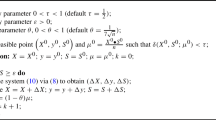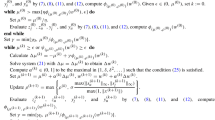Abstract
We propose an efficient primal-dual interior-point relaxation algorithm based on a smoothing barrier augmented Lagrangian, called IPRSDP, for solving semidefinite programming problems in this paper. The IPRSDP algorithm has three advantages over classical interior-point methods. Firstly, IPRSDP does not require the iterative points to be positive definite. Consequently, it can easily be combined with the warm-start technique used for solving many combinatorial optimization problems, which require the solutions of a series of semidefinite programming problems. Secondly, the search direction of IPRSDP is symmetric in itself, and hence the symmetrization procedure is not required any more. Thirdly, with the introduction of the smoothing barrier augmented Lagrangian function, IPRSDP can provide the explicit form of the Schur complement matrix. This enables the complexity of forming this matrix in IPRSDP to be comparable to or lower than that of many existing search directions. The global convergence of IPRSDP is established under suitable assumptions. Numerical experiments are made on the SDPLIB set, which demonstrate the efficiency of IPRSDP.



Similar content being viewed by others
Data availibility
The data that support the findings of this study are available from the corresponding author upon reasonable request.
References
Alizadeh, F., Haeberly, J., Nayakkankuppa, M., Overton, M., Schmieta, S.: SDPPACK User’s Guide–Version 0.9 Beta for Matlab 5.0. New York University (1997)
Alizadeh, F.: Interior point methods in semidefinite programming with applications to combinatorial optimization. SIAM J. Optim. 5(1), 13–51 (1995)
Alizadeh, F., Haeberly, J.P.A., Overton, M.L.: Primal-dual interior-point methods for semidefinite programming: convergence rates, stability and numerical results. SIAM J. Optim. 8(3), 746–768 (1998)
Antoniou, A., Lu, W.S.: Practical Optimization: Algorithms and Engineering Applications, vol. 19. Springer, New York (2007)
Benson, S.J., Ye, Y.Y., Zhang, X.: Solving large-scale sparse semidefinite programs for combinatorial optimization. SIAM J. Optim. 10(2), 443–461 (2000)
Borchers, B.: SDPLIB 1.2, a library of semidefinite programming test problems. Optim. Methods Softw. 11(1–4), 683–690 (1999)
Burer, S., Monteiro, R.D.: A nonlinear programming algorithm for solving semidefinite programs via low-rank factorization. Math. Program. 95(2), 329–357 (2003)
Burer, S., Monteiro, R.D.: Local minima and convergence in low-rank semidefinite programming. Math. Program. 103(3), 427–444 (2005)
Chen, X., Tseng, P.: Non-interior continuation methods for solving semidefinite complementarity problems. Math. Program. 95(3), 431–474 (2003)
Dai, Y.H., Liu, X.W., Sun, J.: A primal-dual interior-point method capable of rapidly detecting infeasibility for nonlinear programs. J. Ind. Manag. Optim. 16(2), 1009–1035 (2020)
De Simone, C., Rinaldi, G.: A cutting plane algorithm for the max-cut problem. Optim. Methods Softw. 3(1–3), 195–214 (1994)
Dolan, E.D., Moré, J.J.: Benchmarking optimization software with performance profiles. Math. Program. 91(2), 201–213 (2002)
Fischer, I., Gruber, G., Rendl, F., Sotirov, R.: Computational experience with a bundle approach for semidefinite cutting plane relaxations of max-cut and equipartition. Math. Program. 105(2), 451–469 (2006)
Helmberg, C., Rendl, F., Vanderbei, R.J., Wolkowicz, H.: An interior-point method for semidefinite programming. SIAM J. Optim. 6(2), 342–361 (1996)
Horn, R.A., Johnson, C.R.: Matrix Analysis. Cambridge University Press, New York (2012)
Huang, Z.H., Liu, X.H.: Extension of smoothing Newton algorithms to solve linear programming over symmetric cones. J. Syst. Sci. Complex. 24, 195–206 (2011)
Kanzow, C., Nagel, C.: Semidefinite programs: new search directions, smoothing-type methods, and numerical results. SIAM J. Optim. 13(1), 1–23 (2002)
Kojima, M., Shindoh, S., Hara, S.: Interior-point methods for the monotone semidefinite linear complementarity problem in symmetric matrices. SIAM J. Optim. 7(1), 86–125 (1997)
Li, Y.F., Wen, Z.W., Yang, C., Yuan, Y.X.: A semismooth Newton method for semidefinite programs and its applications in electronic structure calculations. SIAM J. Sci. Comput. 40(6), 4131–4157 (2018)
Lisser, A., Rendl, F.: Graph partitioning using linear and semidefinite programming. Math. Program. 95(1), 91–101 (2003)
Liu, X.W., Dai, Y.H.: A globally convergent primal-dual interior-point relaxation method for nonlinear programs. Math. Comput. 89(323), 1301–1329 (2019)
Liu, X.W., Dai, Y.H., Huang, Y.K.: A primal-dual interior-point relaxation method with global and rapidly local convergence for nonlinear programs. Math. Methods Oper. Res. 96(3), 351–382 (2022)
Lu, C., Liu, Y.F., Zhang, W.Q., Zhang, S.Z.: Tightness of a new and enhanced semidefinite relaxation for MIMO detection. SIAM J. Optim. 29(1), 719–742 (2019)
Luo, Z.Q., Ma, W.K., So, A.M.-C., Ye, Y.Y., Zhang, S.Z.: Semidefinite relaxation of quadratic optimization problems. IEEE Signal Process. Mag. 27(3), 20–34 (2010)
Mironowicz, P.: Applications of semidefinite optimization in quantum information protocols. arXiv preprint arXiv:1810.05145 (2018)
Monteiro, R.D.: Primal-dual path-following algorithms for semidefinite programming. SIAM J. Optim. 7(3), 663–678 (1997)
Monteiro, R.D.: Polynomial convergence of primal-dual algorithms for semidefinite programming based on the Monteiro and Zhang family of directions. SIAM J. Optim. 8(3), 797–812 (1998)
Monteiro, R.D.: First-and second-order methods for semidefinite programming. Math. Program. 97(1), 209–244 (2003)
Monteiro, R.D., Zanjacomo, P.: Implementation of primal-dual methods for semidefinite programming based on Monteiro and Tsuchiya Newton directions and their variants. Optim. Methods Softw. 11(1–4), 91–140 (1999)
Schmieta, S.H., Alizadeh, F.: Extension of primal-dual interior point algorithms to symmetric cones. Math. Program. 96(3), 409–438 (2003)
Siddhu, V., Tayur, S.: Five starter pieces: Quantum information science via semidefinite programs. arXiv preprint arXiv:2112.08276 (2021)
Sturm, J.F.: Using SeDuMi 1.02, a Matlab toolbox for optimization over symmetric cones. Optim. Methods Softw. 11–12, 625–653 (1999)
Todd, M.J.: A study of search directions in primal-dual interior-point methods for semidefinite programming. Optim. Methods Softw. 11(1–4), 1–46 (1999)
Todd, M.J., Toh, K.C., Tütüncü, R.H.: On the Nesterov–Todd direction in semidefinite programming. SIAM J. Optim. 8(3), 769–796 (1998)
Toh, K.C., Todd, M.J., Tütüncü, R.H.: On the implementation and usage of SDPT3-a Matlab software package for semidefinite quadratic linear programming, version 4.0. In: Handbook on Semidefinite. Conic and Polynomial Optimization, pp. 715–754. Springer, Boston (2012)
Wen, Z.W., Goldfarb, D., Yin, W.T.: Alternating direction augmented Lagrangian methods for semidefinite programming. Math. Program. Comput. 2(3–4), 203–230 (2010)
Yamashita, H., Tanabe, T.: A primal-dual exterior point method for nonlinear optimization. SIAM J. Optim. 20(6), 3335–3363 (2010)
Yang, L.Q., Sun, D.F., Toh, K.C.: SDPNAL \(+ \): a majorized semismooth Newton-CG augmented Lagrangian method for semidefinite programming with nonnegative constraints. Math. Program. Comput. 7(3), 331–366 (2015)
Zhang, R.J., Liu, X.W., Dai, Y.H.: IPRQP: a primal-dual interior-point relaxation algorithm for convex quadratic programming. J. Global Optim. 87(2), 1027–1053 (2023)
Zhang, Y.: On extending some primal-dual interior-point algorithms from linear programming to semidefinite programming. SIAM J. Optim. 8(2), 365–386 (1998)
Zhao, X.Y., Sun, D.F., Toh, K.C.: A Newton-CG augmented Lagrangian method for semidefinite programming. SIAM J. Optim. 20(4), 1737–1765 (2010)
Zheng, Y., Fantuzzi, G., Papachristodoulou, A., Goulart, P., Wynn, A.: Chordal decomposition in operator-splitting methods for sparse semidefinite programs. Math. Program. 180(1), 489–532 (2020)
Acknowledgements
The second author was supported by the NSFC grants (nos. 12071108 and 11671116). The third author was supported by the Natural Science Foundation of China (nos. 12021001, 11991021, 11991020, and 11971372) and the Strategic Priority Research Program of Chinese Academy of Sciences (No. XDA27000000).
Author information
Authors and Affiliations
Corresponding author
Ethics declarations
Conflict of interest
The authors declare that they have no conflict of interest.
Additional information
Publisher's Note
Springer Nature remains neutral with regard to jurisdictional claims in published maps and institutional affiliations.
Appendix: Some proofs
Appendix: Some proofs
Proof of Lemma 3.5
“\(\Longleftarrow \)” First assume that \(X\succ 0,\, S\succ 0,\, XS = \mu I\), which implies that \(XS+SX=2\mu I\). Therefore,
and
“\(\Longrightarrow \)" Assume that \(Z(X,S;\mu ,\rho ) -X = 0\), which results in \(((S-\rho X)^2+4\rho \mu I)^{\frac{1}{2}}=S+\rho X\). After squaring both sides of the equation, we get
This is equivalent to
Suppose there is an eigenvalue decomposition \(X=Q^{\top }\Omega Q\), where \(Q\in {\mathbb {R}}^{n\times n}\) is an orthogonal matrix, \(\Omega = \text {Diag}(\omega _1,\dots ,\omega _n)\). Then (61) can be reformulated as
Define \(\Xi = QSQ^{\top }=(\xi _{ij})_{1\le i\le j \le n}\). Then (62) can be equivalently written as:
or written in a component form:
If \(i=j\), \(2\omega _i \xi _{ii} = 2\mu \) and \(\rho \omega _i+ \xi _{ii} > 0\), this implies \(\omega _i > 0,\forall i = 1,\dots ,n\). As a result, X is a symmetric positive definite matrix. We can demonstrate that S is a symmetric positive definite matrix in a similar manner.
Next we prove that \(XS = \mu I\). Notice that (64) implies \(\xi _{ij}=0\) for all \(i\ne j\). As a result, the matrix \(\Xi \) is diagonal. Due to \(\Omega \Xi +\Xi \Omega = 2\mu I\), we can get \(\Omega \Xi = \mu I\). Then, we obtain \(Q^{\top } \Omega \Xi Q = Q^{\top } \Omega QSQ^{\top }Q = XS = \mu I\) by multiplying this equation left by \(Q^{\top }\) and right by Q. \(\square \)
Proof of Theorem 4.2
The directional derivative of the merit function \(\phi _{(\mu ^{(k)},\rho ^{(k)})}(w)\) at the point \((\mu ^{(k)},w^{(k)})\) along the direction \((\Delta \mu ^{(k)},\Delta w^{(k)})\) is
The Taylor expansion of \({\phi }_{(\mu ^{(k)}+\alpha \Delta \mu ^{(k)},\rho ^{(k)})}(w^{(k)}+\alpha \Delta w^{(k)})\) with respect to \(\alpha \) at \(\alpha = 0\) shows that
Since \(\tau < 1\) and \(\phi _{(\mu ^{(k)},\rho ^{(k)})}(w^{(k)})>0\), the inequality (44) holds for all sufficiently small \(\alpha > 0\). \(\square \)
Proof of Lemma 5.3
Due to Lemma 5.2, we have \(\phi _{(\mu ^{(k)},\rho ^{(k)})}(w^{(k)})\le \phi _{(\mu ^{(0)},\rho ^{(0)})}(w^{(0)})\) for all \(k = 1,2,\dots \) By the monotonicity of the merit function (27), we have
which together with Theorem 5.1 implies that \(\{Z^{(k)}\}\) is bounded. Suppose there exists an eigenvalue decomposition \(S^{(k)}-\rho ^{(k)} X^{(k)}=\displaystyle \sum _{i=1}^n\lambda _i^{(k)} d_i^{(k)}(d_i^{(k)})^\top \), where \(\Vert d_i^{(k)}\Vert = 1,i=1,\dots ,n\). Then
Therefore it is sufficient to prove that \(\dfrac{\sqrt{(\lambda _i^{(k)})^2+4\rho ^{(k)}\mu ^{(k)}}+\lambda _i^{(k)}}{2\rho ^{(k)}}, i =1,\dots ,n\) are bounded. For any \( i =1,\dots ,n\), we have
Thus, \(\dfrac{\sqrt{(\lambda _i^{(k)})^2+4\rho ^{(k)}\mu ^{(k)}}+\lambda _i^{(k)}}{2\rho ^{(k)}}, i=1,\dots ,n\) are bounded under Assumption 3.1, which implies that the sequence \(\{Y^{(k)}\}\) is bounded.
Due to \(\rho ^{(k)}Y^{(k)}Z^{(k)}=\mu ^{(k)}I\), we get \(\Vert Y^{(k)}Z^{(k)}\Vert _F=\sqrt{n}\dfrac{\mu ^{(k)}}{\rho ^{(k)}}\). Combining with the boundedness of \(\{Y^{(k)}\}\) and \(\{Z^{(k)}\}\), one has the desired inequalities. \(\square \)
Rights and permissions
Springer Nature or its licensor (e.g. a society or other partner) holds exclusive rights to this article under a publishing agreement with the author(s) or other rightsholder(s); author self-archiving of the accepted manuscript version of this article is solely governed by the terms of such publishing agreement and applicable law.
About this article
Cite this article
Zhang, RJ., Liu, XW. & Dai, YH. IPRSDP: a primal-dual interior-point relaxation algorithm for semidefinite programming. Comput Optim Appl 88, 1–36 (2024). https://doi.org/10.1007/s10589-024-00558-8
Received:
Accepted:
Published:
Issue Date:
DOI: https://doi.org/10.1007/s10589-024-00558-8




